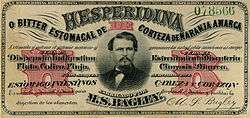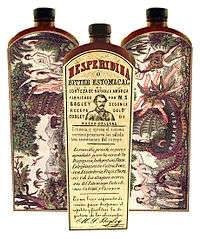Hesperidina
|
Anverse and reverse of the first Hesperidina bottles, c. 1864. | |
| Type | Aperitif |
|---|---|
| Manufacturer | Bagley |
| Introduced | 1864 |
| Flavour | Bitter orange |
| Website | bagley.com.ar |
Hesperidina is a classic Argentine apéritif made from bitter and sweet orange peels, with contain a high number of flavonoids. The beverage has antioxidant effects because of the flavonoids.[1]
Its name was taken from the Greek myth of Hesperides.
History

This alcoholic drink was invented in 1864 by an American immigrant, Melville Sewell Bagley, in Buenos Aires, Argentina.[2] Bagley was a native of the state of Maine. He had been involved in the dry goods business in New Orleans before the outbreak of the American Civil War. After the outbreak he emigrated to Buenos Aires where he worked at "La Estrella" pharmacy, sited on Defensa and Alsina streets. Bagley started to try with different formulas to create a digestive beverage, using oranges as its main ingredient.[3] The Hesperidina would be born from those tests.[4]
Prior to the official launching of the drink, Bagley made an extensive public campaign with posters spread in the city of Buenos Aires. Those posters only had the word "Hesperidina", without images or further explanations about the subject in question.[5]
The poster campaign lasted three months until Hesperidina was finally launched on December 24, 1864, with an advertisement published in La Tribuna newspaper. The advertisement stated Hesperidina was a "stomach digestive, prepared with bitter oranges." The immediate success of the apéritif led to the appearance of imitations and other counterfeiting of the product. Alarmed by the situation, Bagley convinced president of Argentina, Nicolás Avellaneda to create a patent and trademark office in order to protect his product. The office was created in 1876, being Hesperidina the first product to register as a trademark in Argentina on October 27.[6] Soon after, Bagley began to print the Hesperidina labels at the New York Bank Note Company to strengthen controls over the product.
During the Triple Alliance War (1864–1870) Hesperidina was distributed among the soldiers "to revitalize the wounded" because of its therapeutic effects that could solve stomach problems, derived from the non-potable water drank by the combatants.[4]
Beverages, indeed, opened the door to a whole new sector of advertisement driven by the Hesperidina campaign and the arrival to the country of world-wide "food and beverage" names such as Real Hollands, Nestlé, Domecq and Bols among others.
In popular culture
The Hesperidina is mentioned in three short tales by Julio Cortázar: Casa Tomada, Tía en Apuros and Circe. Another writer, Juan Carlos Casas, also included Hesperidina in his book Fraile Muerto.[7] Hesperidina also appeared in the short tale Perdido by Haroldo Conti.[8]
Tango singer Roberto Goyeneche referred Hesperidina as his favorite beverage, which he used to drink at "La Sirena", a bar in Saavedra, Buenos Aires. The Hesperidina also appeared in several calendars painted by Gauchesco artist Florencio Molina Campos.[4] Other famous person that adopted Hesperidina as his favorite drink was explorer Francisco Moreno, who used to drink it during his trips to the harsher regions of the south of Argentina.[5]
French musician José de Wravrin (mostly known artistic name, Juan Nirvassed) composed Hesperidina: Tango de Moda in 1915.,[9] which would later won first prize at Sociedad Sportiva Argentina. Hesperidina is also mentioned in the film Juan Moreira directed by Leonardo Favio in 1973.[4]
See also
References
- ↑ "Contenido de glicósidos de flavonoides en frutos inmaduros en Citrus aurantium y Citrus sinensis" on Información Tecnológica n° 13, edited by C.I.T. of Argentina - ISSN 0716-8756
- ↑ Paul H. Lewis (1990), The Crisis of Argentine Capitalism, University of North Carolina Press, pp. 59–60, ISBN 9780807818626
- ↑ Norteamericanos en la Argentina by Lucio Pérez Calvo, 2007 - ISBN 987-05-2845-7
- 1 2 3 4 "Hesperidina: el licor que dio lugar al registro de patentes en el país", iEco (suplement of Clarín), 13 Oct 2014
- 1 2 "Hesperidina, el retorno de una leyenda" by Sandra Calvete, Los Andes, 29 Jul 2013
- ↑ , Revolución Industrial y Equipamiento Urbano by Jorge Gazaneo & Mabel Scarone - Instituto de Arte Americano e Investigaciones Estéticas, 1967
- ↑ Fraile muerto by Juan C. Casas, Editorial Stokcero, 2002, ISBN 987-20506-5-1, ISBN 978-987-20506-5-8
- ↑ Haroldo Conti bio
- ↑ "Hesperitango"
External links
| Wikimedia Commons has media related to Hesperidina. |
